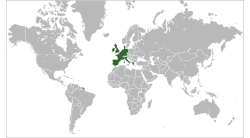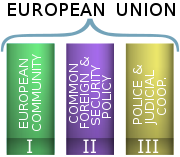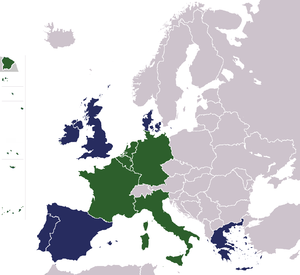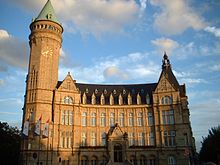- European Economic Community
-
"EEC" redirects here. For other uses, see EEC (disambiguation).This article is about the multinational organization established in 1957 and became part of the first European Union pillar from 1993 to 2009. For the collective of the three European communities and the EU pillar they comprised until 2009, see European Communities.
European Economic Community
(later, European Community¹)Danish: Europæiske Økonomiske Fællesskab Dutch: Europese Economische Gemeenschap French: Communauté économique européenne German: Europäische Wirtschaftsgemeinschaft Greek: Ευρωπαϊκή Οικονομική Κοινότητα Italian: Comunità Economica Europea Portuguese: Comunidade Económica Europeia Spanish: Comunidad Económica Europea Sui generis international organisation 1958–1993  →
→Anthem
Ode to Joy (orchestral)Map of the EEC in the world, at its end in 1993. Capital Brussels
Luxembourg
Strasbourg²Language(s) Political structure International organization Commission President - 1958-1967 Walter Hallstein - 1967-1970 Jean Rey (politician) - 1973-1977 François-Xavier Ortoli - 1977-1981 Roy Jenkins - 1981-1985 Gaston Thorn - 1985-1993 Jacques Delors Legislature Legislature - Upper house Council of Ministers - Lower house European Parliament Historical era Cold War - Treaty signing 25 March 1957 - Established 1 January 1958 - European Communities 1 July 1967 - Becomes part of a Pillar 1 November 1993 - Pillar abolished 1 December 2009 Currency Different currencies;- ECU/EUA (accounting)
- Belgian franc
- Danish krone
- French franc
- German mark
- Greek drachma
- Irish pound
- Italian lira
- Luxembourgisg franc
- Dutch guilder
- Portuguese escudo
- Spanish peseta
- British pound
Today part of  European Union
European Union¹ The information in this infobox covers the EEC's time as an independent organisation. It does not give details of post-1993 operation within the EU as that is explained in greater length in the European Union and European Communities articles.
² De facto only, these cities hosted the main institutions but were not titled as capitals due to the EEC being primarily an international organisation.History of the European Union 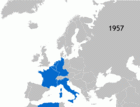
This article is part of a seriesOrganisationTopics
European Union Portal
The European Economic Community (EEC) (also known as the Common Market in the English-speaking world, renamed the European Community (EC) in 1993[note 1]) was an international organisation created with a view to bring about economic integration (including a single market) among the Inner Six of European integration: Belgium, France, Germany, Italy, Luxembourg and the Netherlands.
The EEC was created by the Treaty establishing the European Economic Community (Treaty of Rome; renamed Treaty on the functioning of the European Union in 2009) of 1957. It gained a common set of institutions along with the European Coal and Steel Community (ECSC) and the European Atomic Energy Community (EURATOM) (collectively, the European Communities) under the 1965 Merger Treaty (Treaty of Brussels). With the entry into force of the Treaty on European Union (Treaty of Maastricht) in 1993, the organisation changed its name from the European Economic Community to the European Community (reflecting the increasing scope of European integration), and was along with the other aforementioned European Communities made to comprise the first of the three pillars of the new European Union (EU). The entire pillar division, and the EC along with it, were abolished upon the entry into force of the Treaty of Lisbon in 2009. The legal personality of the EC was at this point transferred to the EU as a whole, a change in line with the Lisbon Treaty's wider aim of consolidating the legal nature of the Union.
Contents
History
Background
In 1951, the Treaty of Paris was signed, creating the European Coal and Steel Community (ECSC). This was an international community based on supranationalism and international law, designed to help the economy of Europe and prevent future war by integrating its members.
In the aim of creating a federal Europe two further communities were proposed: a European Defence Community (EDC) and a European Political Community (EPC). While the treaty for the latter was being drawn up by the Common Assembly, the ECSC parliamentary chamber, the EDC was rejected by the French Parliament. President Jean Monnet, a leading figure behind the communities, resigned from the High Authority in protest and began work on alternative communities, based on economic integration rather than political integration.[1] After the Messina Conference in 1955, Paul Henri Spaak was given the task to prepare a report on the idea of a customs union. The so-called Spaak Report[2] of the Spaak Committee formed the cornerstone of the intergovernmental negotiations at Val Duchesse castle in 1956. Together with the Ohlin Report the Spaak Report would provide the basis for the Treaty of Rome.
In 1956, Paul Henri Spaak led the Intergovernmental Conference on the Common Market and Euratom at the Val Duchesse castle, which prepared for the Treaty of Rome in 1957. The conference led to the signature, on 25 March 1957, of the Treaty of Rome establishing a European Economic Community.
Creation and early years
The resulting communities were the European Economic Community (EEC) and the European Atomic Energy Community (EAEC or Euratom). These were markedly less supranational than the previous communities, due to protests from some countries that their sovereignty was being infringed (however there would still be concerns with the behaviour of the Hallstein Commission). The first formal meeting of the Hallstein Commission, was held on 16 January 1958 at the Castle of the Valley of the Duchess. The EEC (direct ancestor of the modern Community) was to create a customs union while Euratom would promote co-operation in the nuclear power sphere. The EEC rapidly became the most important of these and expanded its activities. One of the first important accomplishments of the EEC was the establishment (1962) of common price levels for agricultural products. In 1968, internal tariffs (tariffs on trade between member nations) were removed on certain products.
Another crisis was triggered in regard to proposals for the financing of the Common Agricultural Policy, which came into force in 1962. The transitional period whereby decisions were made by unanimity had come to an end, and majority-voting in the Council had taken effect. Then-French President Charles de Gaulle's opposition to supranationalism and fear of the other members challenging the CAP led to an "empty chair policy" where by French representatives were withdrawn from the European institutions until the French veto was reinstated. Eventually, a compromise was reached with the Luxembourg compromise on 29 January 1966 whereby a gentlemen's agreement permitted members to use a veto on areas of national interest.[3][4]
On 1 July 1967 when the Merger Treaty came into operation, combining the institutions of the ECSC and Euratom into that of the EEC, they already shared a Parliamentary Assembly and Courts. Collectively they were known as the European Communities. The Communities still had independent personalities although were increasingly integrated. Future treaties granted the community new powers beyond simple economic matters which had achieved a high level of integration. As it got closer to the goal of political integration and a peaceful and united Europe, what Mikhail Gorbachev described as a Common European Home.
Enlargement and elections
 French President Charles de Gaulle vetoed British membership, held back the development of Parliament's powers and was at the centre of the 'empty chair crisis' of 1965
French President Charles de Gaulle vetoed British membership, held back the development of Parliament's powers and was at the centre of the 'empty chair crisis' of 1965
The 1960s saw the first attempts at enlargement. On 3 May 1960 Denmark, Ireland, Norway and the United Kingdom applied to join the three Communities. However, President Charles de Gaulle saw British membership as a Trojan horse for US influence and vetoed membership, and the applications of all four countries were suspended.
The four countries resubmitted their applications on 11 May 1967 and with Georges Pompidou succeeding Charles de Gaulle as French President in 1969, the veto was lifted. Negotiations began in 1970 under the pro-European government of Edward Heath, who had to deal with disagreements relating to the Common Agricultural Policy and the UK's relationship with the Commonwealth of Nations. Nevertheless, two years later the accession treaties were signed and all but Norway acceded to the Community (Norway rejected membership in a referendum).
The Treaties of Rome had stated that the European Parliament must be directly elected, however this required the Council to agree on a common voting system first. The Council procrastinated on the issue and the Parliament remained appointed,[5] French President Charles de Gaulle was particularly active in blocking the development of the Parliament, with it only being granted Budgetary powers following his resignation.
Parliament pressured for agreement and on 20 September 1976 the Council agreed part of the necessary instruments for election, deferring details on electoral systems which remain varied to this day.[5] During the tenure of President Jenkins, in June 1979, the elections were held in all the then-members (see European Parliament election, 1979).[6] The new Parliament, galvanised by direct election and new powers, started working full time and became more active than the previous assemblies.[5]
Shortly after its election, Parliament became the first Community institution to propose that the Community adopt the Flag of Europe.[7] The European Council agreed to this and adopted the Symbols of Europe as those of the Community in 1984.[8] The European Council, or European summit, had developed since the 1960s as an informal meeting of the Council at the level of heads of state. It had originated from then-French President Charles de Gaulle's resentment at the domination of supranational institutions (e.g. the Commission) over the integration process. It was mentioned in the treaties for the first time in the Single European Act (see below).[9]
Towards Maastricht
Greece applied to join the community on 12 June 1975, following the restoration of democracy, and joined on 1 January 1981.[10] Following on from Greece, and after their own democratic restoration, Spain and Portugal applied to the communities in 1977 and joined together on 1 January 1986.[11] In 1987 Turkey formally applied to join the Community and began the longest application process for any country.
With the prospect of further enlargement, and a desire to increase areas of co-operation, the Single European Act was signed by the foreign ministers on the 17 and 28 February 1986 in Luxembourg and the Hague respectively. In a single document it dealt with reform of institutions, extension of powers, foreign policy cooperation and the single market. It came into force on 1 July 1987.[12] The act was influenced by work on what would be the Maastricht Treaty, which was agreed on 10 December 1991, signed the following year and coming into force on 1 November 1993 establishing the EU.
European Community
European Communities Pillars of the European Union The three former pillars constituting the European Union (clickable) EEC ← 1993-2009 → EU The EU absorbed the European Communities as one of its three pillars. The EEC's areas of activities were enlarged and were renamed the European Community, continuing to follow the supranational structure of the EEC. The EEC institutions became those of the EU, however the Court, Parliament and Commission had only limited input in the new pillars, as they worked on a more intergovernmental system than the European Communities. This is reflected in the names of the institutions, the Council is formally the "Council of the European Union" while the Commission is formally the "Commission of the European Communities".
However, after the Treaty of Maastricht, Parliament gained a much bigger role. Maastricht brought in the codecision procedure, which gave it equal legislative power with the Council on Community matters. Hence, with the greater powers of the supranational institutions and the operation of Qualified Majority Voting in the Council, the Community pillar could be described as a far more federal method of decision making.
The Treaty of Amsterdam transferred responsibility for free movement of persons (e.g. visas, illegal immigration, asylum) from the Justice and Home Affairs (JHA) pillar to the European Community (JHA was renamed Police and Judicial Co-operation in Criminal Matters (PJCC) as a result).[13] Both Amsterdam and the Treaty of Nice also extended codecision procedure to nearly all policy areas, giving Parliament equal power to the Council in the Community.
In 2002, the Treaty of Paris which established the ECSC expired, having reached its 50 year limit (as the first treaty, it was the only one with a limit). No attempt was made to renew its mandate; instead, the Treaty of Nice transferred certain of its elements to the Treaty of Rome and hence its work continued as part of the EC area of the European Community's remit.
After the entry into force of the Treaty of Lisbon in 2009 the pillar structure ceased to exist. The European Community, together with its legal personality, was transferred to the newly consolidated European Union which merged in the other two pillars (however Euratom remained distinct). This was originally proposed under the European Constitution but that treaty failed ratification in 2005.
Aims and achievements
The main aim of the EEC, as stated in its preamble, was to "preserve peace and liberty and to lay the foundations of an ever closer union among the peoples of Europe". Calling for balanced economic growth, this was to be accomplished through:[14]
- The establishment of a customs union with a common external tariff
- Common policies for agriculture, transport and trade
- Enlargement of the EEC to the rest of Europe
For the customs union, the treaty provided for a 10% reduction in custom duties and up to 20% of global import quotas. Progress on the customs union proceeded much faster than the twelve years planned. However, France faced some setbacks due to their war with Algeria.[15]
Members
The six states that founded the EEC and the other two Communities were known as the "inner six" (the "outer seven" were those countries who formed the European Free Trade Association). The six were France, West Germany, Italy and the three Benelux countries: Belgium, the Netherlands and Luxembourg. The first enlargement was in 1973, with the accession of Denmark, Ireland and the United Kingdom. Greece, Spain and Portugal joined throughout in the 1980s. Following the creation of the EU in 1993, it has enlarged to include a further fifteen countries by 2007.
Flag State Accession Language(s) Currency Population
(1990)[16]
Belgium 25 March 1957 Dutch, French and German Belgian franc[17] 10,016,000 
Denmark 1 January 1973 Danish Danish krone 5,146,500 
France 25 March 1957 French French franc 56,718,000 
West Germany[18] 25 March 1957 German German mark 63,254,000[19] 
Greece 1 January 1981 Greek Greek drachma 10,120,000 
Ireland 1 January 1973 Irish and English Irish pound 3,521,000 
Italy 25 March 1957 Italian Italian lira 56,762,700 
Luxembourg 25 March 1957 French, German and Luxembourgish Luxembourgish franc[17] 384,400 
Netherlands 25 March 1957 Dutch Dutch guilder 14,892,300 
Portugal 1 January 1986 Portuguese Portuguese escudo 9,862,500 
Spain 1 January 1986 Spanish[note 2] Spanish peseta 38,993,800 
United Kingdom 1 January 1973 English Pound sterling 57,681,000 Member states are represented in some form in each institution. The Council is also composed of one national minister who represents their national government. Each state also has a right to one European Commissioner each, although in the European Commission they are not supposed to represent their national interest but that of the Community. Prior to 2004, the larger members (France, Germany, Italy and the United Kingdom) have had two Commissioners. In the European Parliament, members are allocated a set number seats related to their population, however these (since 1979) have been directly elected and they sit according to political allegiance, not national origin. Most other institutions, including the European Court of Justice, have some form of national division of its members.
Institutions
There were three political institutions which held the executive and legislative power of the EEC, plus one judicial institution and a fifth body created in 1975. These institutions (except for the Auditors) were created in 1957 by the EEC but from 1967 onwards they applied to all three Communities. The Council represents governments, the Parliament represents citizens and the Commission represents the European interest.[20] Essentially, the Council, Parliament or another party place a request for legislation to the Commission. The Commission then drafts this and presents it to the Council for approval and the Parliament for an opinion (in some cases it had a veto, depending upon the legislative procedure in use). The Commission's duty is to ensure it is implemented by dealing with the day-to-day running of the Union and taking others to Court if they fail to comply.[20] After the Maastricht treaty in 1993, these institutions became those of the European Union, though limited in some areas due to the pillar structure. Despite this, Parliament in particular has gained more power over legislation and security of the Commission. The Court was the highest authority in the law, settling legal disputes in the Community, while the Auditors had no power but to investigate.
Background
The EEC inherited some of the Institutions of the ECSC in that the Common Assembly and Court of Justice of the ECSC had their authority extended to the EEC and Euratom in the same role. However the EEC, and Euratom, had different executive bodies to the ECSC. In place of the ECSC's Council of Ministers was the Council of the European Economic Community, and in place of the High Authority was the Commission of the European Communities.
There was greater difference between these than name: the French government of the day had grown suspicious of the supranational power of the High Authority and sought to curb its powers in favour of the intergovernmental style Council. Hence the Council had a greater executive role in the running of the Community than was the situation in the EEC. By virtue of the Merger Treaty in 1967, the executives of the ECSC and Euratom were merged with that of the EEC, creating a single institutional structure governing the three separate Communities. From here on, the term European Communities were used for the institutions (for example, from Commission of the European Economic Community to the Commission of the European Communities.[21][22][23]
Council

The Council of the European Communities was a body holding legislative and executive powers and was thus the main decision making body of the Community. Its Presidency rotated between the states every six months and it is related to the European Council, which was an informal gather of national leaders (started in 1961) on the same basis as the Council.[24]
The Council was composed of one national ministers from each state. However the Council meets in various forms depending upon the topic. For example, if agriculture was being discussed, the Council would be composed of each national minister for agriculture. They represented their governments and were accountable to their national political systems. Votes were taken either by majority (with votes allocated according to population) or unanimity. In these various forms they share some legislative and budgetary power of the Parliament.[24] Since the 1960s the Council also began to meet informally at the level of national leaders; these European summits followed the same presidency system and secretariat as the Council but was not a formal formation of it.
Commission
The Commission of the European Communities was the executive arm of the community, drafting Community law, dealing with the day to running of the Community and upholding the treaties. It was designed to be independent, representing the Community interest, but was composed of national representatives (two from each of the larger states, one from the smaller states). One of its members was the President, appointed by the Council, who chaired the body and represented it.
Parliament
The European Parliament held its first elections in 1979, slowly gaining more influence over Community decision making.
Under the Community, the European Parliament (formerly the European Parliamentary Assembly) had an advisory role to the Council and Commission. There were a number of Community legislative procedures, at first there was only the consultation procedure, which meant Parliament had to be consulted, although it was often ignored. The Single European Act gave Parliament more power, with the assent procedure giving it a right to veto proposals and the cooperation procedure giving it equal power with the Council if the Council was not unanimous.
In 1970 and 1975, the Budgetary treaties gave Parliament power over the Community budget. The Parliament's members, up-until 1979 were national MPs serving part time in the Parliament. The Treaties of Rome had required elections to be held once the Council had decided on a voting system, but this did not happen and elections were delayed until 1979 (see European Parliament election, 1979). After that, Parliament was elected every five years.
Court
The Court of Justice of the European Communities was the highest court of on matters of Community law and was composed of one judge per state with a President elected from among them. Its role was to ensure that Community law was applied in the same way across all states and to settle legal disputes between institutions or states. It became a powerful institution as Community law overrides national law.
Auditors
The fifth institution is the European Court of Auditors, which despite its name had no judicial powers like the Court of Justice. Instead, it ensured that taxpayer funds from the Community budget have been correctly spent. The court provided an audit report for each financial year to the Council and Parliament and gives opinions and proposals on financial legislation and anti-fraud actions. It is the only institution not mentioned in the original treaties, having been set up in 1975.[25]
Policy areas
At the time of its abolition, the European Community pillar covered the following areas;[13]
- Immigration policy
- Research
- Schengen treaty
- Social policy
- Trade policy
- Trans-European Networks
See also
- Brussels and the European Union
- Delors Commission
- European Commission
- European Customs Information Portal (ECIP)
- European Institutions in Strasbourg
- History of the European Communities (1958-1972)
- History of the European Communities (1973-1993)
- Location of European Union institutions
Notes and references
Notes
- ^ The information in this article primarily covers the EEC's time as an independent organisation. Post 1993 most of the European Community's activities are dominated by the European Union or the European Communities pillar specifically. Please see those articles for details post 1993. Likewise, the infobox deals with the EEC as an independent organisation, rather than both the EEC and the pillar.
- ^ And recognised regional languages: Aranese, Galician, Basque and Catalan
References
- ^ Raymond F. Mikesell, The Lessons of Benelux and the European Coal and Steel Community for the European Economic Community, The American Economic Review, Vol. 48, No. 2, Papers and Proceedings of the Seventieth Annual Meeting of the American Economic Association (May, 1958), pp. 428-441
- ^ Spaak report
- ^ Fifty years of fraternal rivalry news.bbc.co.uk 19/03/07
- ^ The 'empty chair' policy
- ^ a b c Hoskyns, Catherine; Michael Newman (2000). Democratizing the European Union: Issues for the twenty-first Century (Perspectives on Democratization). Manchester University Press. ISBN 978-0719056666.
- ^ Election of the President of the European Parliament, European Parliament
- ^ "Council of Europe's Emblems". Council of Europe. Archived from the original on 2007-08-07. http://web.archive.org/web/20070807045151/http://www.coe.int/T/E/Com/About_Coe/flag.asp. Retrieved 2007-08-16.
- ^ "The European flag: questions and answers". European NAvigator. http://www.ena.lu/european-flag-questions-answers-2005-030006774.html. Retrieved 2007-08-16.
- ^ Stark, Christine. "Evolution of the European Council: The implications of a permanent seat" (PDF). Dragoman.org. http://www.dragoman.org/ec/belfast-2002.pdf. Retrieved 2007-07-12.
- ^ The accession treaty with Greece
- ^ The Accession Treaties with Spain and Portugal ena.li
- ^ Single European Act
- ^ a b What are the three pillars of the EU?, Folketingets EU-Oplysning
- ^ "The achievements of the EEC". European NAvigator. http://www.ena.lu?lang=2&doc=399. Retrieved 2008-01-31.
- ^ "The European Customs Union". European NAvigator. http://www.ena.lu?lang=2&doc=420. Retrieved 2008-01-31.
- ^ Data from Populstat.info
- ^ a b The Belgian and Luxembourgish francs were 1:1 and theoretically interchangeable as a single currency.
- ^ German reunification took place in 1990
- ^ Including East Germany: 80,274,200
- ^ a b "Institutions: The European Commission". Europa (web portal). http://europa.eu/institutions/inst/comm/index_en.htm. Retrieved 2007-06-25.
- ^ "Merging of the executives". European NAvigator. http://www.ena.lu?lang=2&doc=473. Retrieved 2007-07-09.
- ^ "Council of the European Union". European NAvigator. http://www.ena.lu?lang=2&doc=5604. Retrieved 2007-06-24.
- ^ "European Commission". European NAvigator. http://www.ena.lu?lang=2&doc=3202. Retrieved 2007-06-18.
- ^ a b "Institutions: The Council of the European Union". Europa (web portal). http://europa.eu/institutions/inst/council/index_en.htm. Retrieved 2007-06-25.
- ^ "Institutions: Court of Auditors". Europa (web portal). http://europa.eu/institutions/inst/auditors/index_en.htm. Retrieved 2007-06-25.
Further reading
- Jean Monnet, Prospect for a New Europe (1959)
- Bela Balassa, The Theory of Economic Integration (1962)
- Walter Hallstein, A New Path to Peaceful Union (1962)
- Paul-Henri Spaak, The Continuing Battle: Memories of a European (1971)
External links
- European Union website
- Treaty establishing the European Economic Community European NAvigator
- History of the Rome Treaties European NAvigator
- Papers of J. Robert Schaetzel, ambassador to European Economic Community, 1966-1972, Dwight D. Eisenhower Presidential Library
- European Customs Information Portal (ECIP)
Signed
In force
Document1948
1948
Brussels Treaty1951
1952
Paris Treaty1954
1955
Modified Brussels Treaty1957
1958
Rome treaties1965
1967
Merger Treaty1975
N/A
European Council conclusion1985
1985
Schengen Treaty1986
1987
Single European Act1992
1993
Maastricht Treaty1997
1999
Amsterdam Treaty2001
2003
Nice Treaty2007
2009
Lisbon Treaty







Three pillars of the European Union: European Communities: European Atomic Energy Community (EURATOM) European Coal and Steel Community (ECSC) Treaty expired in 2002 European Union (EU) European Economic Community (EEC) Schengen Rules European Community (EC) TREVI Justice and Home Affairs (JHA) Police and Judicial Co-operation in Criminal Matters (PJCC) European Political Cooperation (EPC) Common Foreign and Security Policy (CFSP) Unconsolidated bodies Western European Union (WEU) Treaty terminated in 2010 Categories:- History of the European Union
- Organizations established in 1958
- Organizations disestablished in 1993
- Former international organizations
Wikimedia Foundation. 2010.


